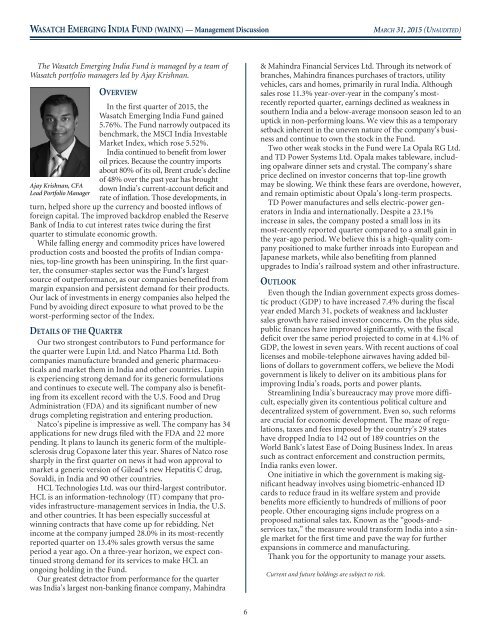WASATCH FUNDS - Curian Clearing
WASATCH FUNDS - Curian Clearing
WASATCH FUNDS - Curian Clearing
You also want an ePaper? Increase the reach of your titles
YUMPU automatically turns print PDFs into web optimized ePapers that Google loves.
<strong>WASATCH</strong> EMERGING INDIA FUND (WAINX) — Management Discussion<br />
MARCH 31, 2015 (UNAUDITED)<br />
The Wasatch Emerging India Fund is managed by a team of<br />
Wasatch portfolio managers led by Ajay Krishnan.<br />
Ajay Krishnan, CFA<br />
Lead Portfolio Manager<br />
OVERVIEW<br />
In the first quarter of 2015, the<br />
Wasatch Emerging India Fund gained<br />
5.76%. The Fund narrowly outpaced its<br />
benchmark, the MSCI India Investable<br />
Market Index, which rose 5.52%.<br />
India continued to benefit from lower<br />
oil prices. Because the country imports<br />
about 80% of its oil, Brent crude’s decline<br />
of 48% over the past year has brought<br />
down India’s current-account deficit and<br />
rate of inflation. Those developments, in<br />
turn, helped shore up the currency and boosted inflows of<br />
foreign capital. The improved backdrop enabled the Reserve<br />
Bank of India to cut interest rates twice during the first<br />
quarter to stimulate economic growth.<br />
While falling energy and commodity prices have lowered<br />
production costs and boosted the profits of Indian companies,<br />
top-line growth has been uninspiring. In the first quarter,<br />
the consumer-staples sector was the Fund’s largest<br />
source of outperformance, as our companies benefited from<br />
margin expansion and persistent demand for their products.<br />
Our lack of investments in energy companies also helped the<br />
Fund by avoiding direct exposure to what proved to be the<br />
worst-performing sector of the Index.<br />
DETAILS OF THE QUARTER<br />
Our two strongest contributors to Fund performance for<br />
the quarter were Lupin Ltd. and Natco Pharma Ltd. Both<br />
companies manufacture branded and generic pharmaceuticals<br />
and market them in India and other countries. Lupin<br />
is experiencing strong demand for its generic formulations<br />
and continues to execute well. The company also is benefiting<br />
from its excellent record with the U.S. Food and Drug<br />
Administration (FDA) and its significant number of new<br />
drugs completing registration and entering production.<br />
Natco’s pipeline is impressive as well. The company has 34<br />
applications for new drugs filed with the FDA and 22 more<br />
pending. It plans to launch its generic form of the multiplesclerosis<br />
drug Copaxone later this year. Shares of Natco rose<br />
sharply in the first quarter on news it had won approval to<br />
market a generic version of Gilead’s new Hepatitis C drug,<br />
Sovaldi, in India and 90 other countries.<br />
HCL Technologies Ltd. was our third-largest contributor.<br />
HCL is an information-technology (IT) company that provides<br />
infrastructure-management services in India, the U.S.<br />
and other countries. It has been especially successful at<br />
winning contracts that have come up for rebidding. Net<br />
income at the company jumped 28.0% in its most-recently<br />
reported quarter on 13.4% sales growth versus the same<br />
period a year ago. On a three-year horizon, we expect continued<br />
strong demand for its services to make HCL an<br />
ongoing holding in the Fund.<br />
Our greatest detractor from performance for the quarter<br />
was India’s largest non-banking finance company, Mahindra<br />
& Mahindra Financial Services Ltd. Through its network of<br />
branches, Mahindra finances purchases of tractors, utility<br />
vehicles, cars and homes, primarily in rural India. Although<br />
sales rose 11.3% year-over-year in the company’s mostrecently<br />
reported quarter, earnings declined as weakness in<br />
southern India and a below-average monsoon season led to an<br />
uptick in non-performing loans. We view this as a temporary<br />
setback inherent in the uneven nature of the company’s business<br />
and continue to own the stock in the Fund.<br />
Two other weak stocks in the Fund were La Opala RG Ltd.<br />
and TD Power Systems Ltd. Opala makes tableware, including<br />
opalware dinner sets and crystal. The company’s share<br />
price declined on investor concerns that top-line growth<br />
may be slowing. We think these fears are overdone, however,<br />
and remain optimistic about Opala’s long-term prospects.<br />
TD Power manufactures and sells electric-power generators<br />
in India and internationally. Despite a 23.1%<br />
increase in sales, the company posted a small loss in its<br />
most-recently reported quarter compared to a small gain in<br />
the year-ago period. We believe this is a high-quality company<br />
positioned to make further inroads into European and<br />
Japanese markets, while also benefiting from planned<br />
upgrades to India’s railroad system and other infrastructure.<br />
OUTLOOK<br />
Even though the Indian government expects gross domestic<br />
product (GDP) to have increased 7.4% during the fiscal<br />
year ended March 31, pockets of weakness and lackluster<br />
sales growth have raised investor concerns. On the plus side,<br />
public finances have improved significantly, with the fiscal<br />
deficit over the same period projected to come in at 4.1% of<br />
GDP, the lowest in seven years. With recent auctions of coal<br />
licenses and mobile-telephone airwaves having added billions<br />
of dollars to government coffers, we believe the Modi<br />
government is likely to deliver on its ambitious plans for<br />
improving India’s roads, ports and power plants.<br />
Streamlining India’s bureaucracy may prove more difficult,<br />
especially given its contentious political culture and<br />
decentralized system of government. Even so, such reforms<br />
are crucial for economic development. The maze of regulations,<br />
taxes and fees imposed by the country’s 29 states<br />
have dropped India to 142 out of 189 countries on the<br />
World Bank’s latest Ease of Doing Business Index. In areas<br />
such as contract enforcement and construction permits,<br />
India ranks even lower.<br />
One initiative in which the government is making significant<br />
headway involves using biometric-enhanced ID<br />
cards to reduce fraud in its welfare system and provide<br />
benefits more efficiently to hundreds of millions of poor<br />
people. Other encouraging signs include progress on a<br />
proposed national sales tax. Known as the “goods-andservices<br />
tax,” the measure would transform India into a single<br />
market for the first time and pave the way for further<br />
expansions in commerce and manufacturing.<br />
Thank you for the opportunity to manage your assets.<br />
Current and future holdings are subject to risk.<br />
6




